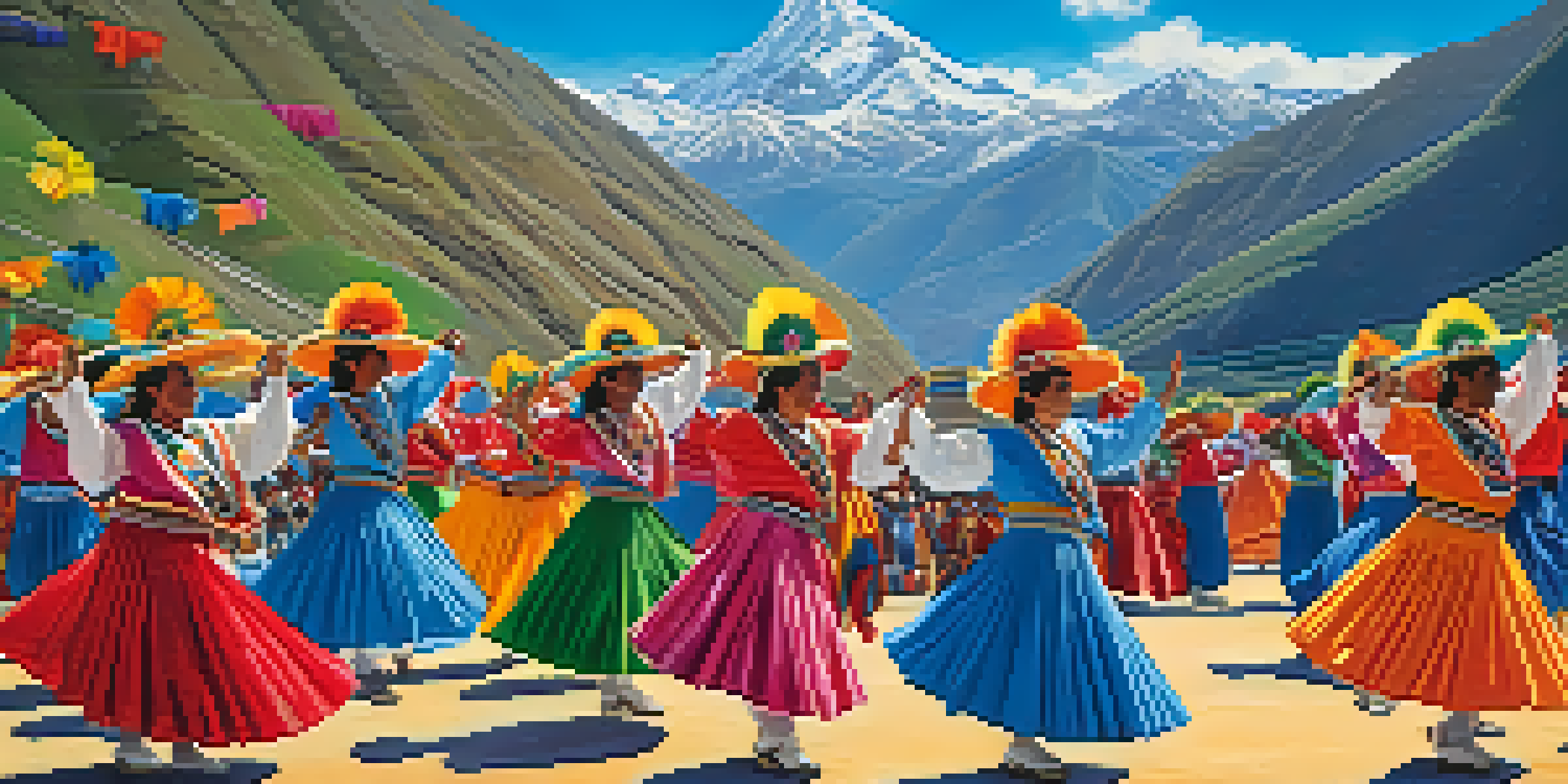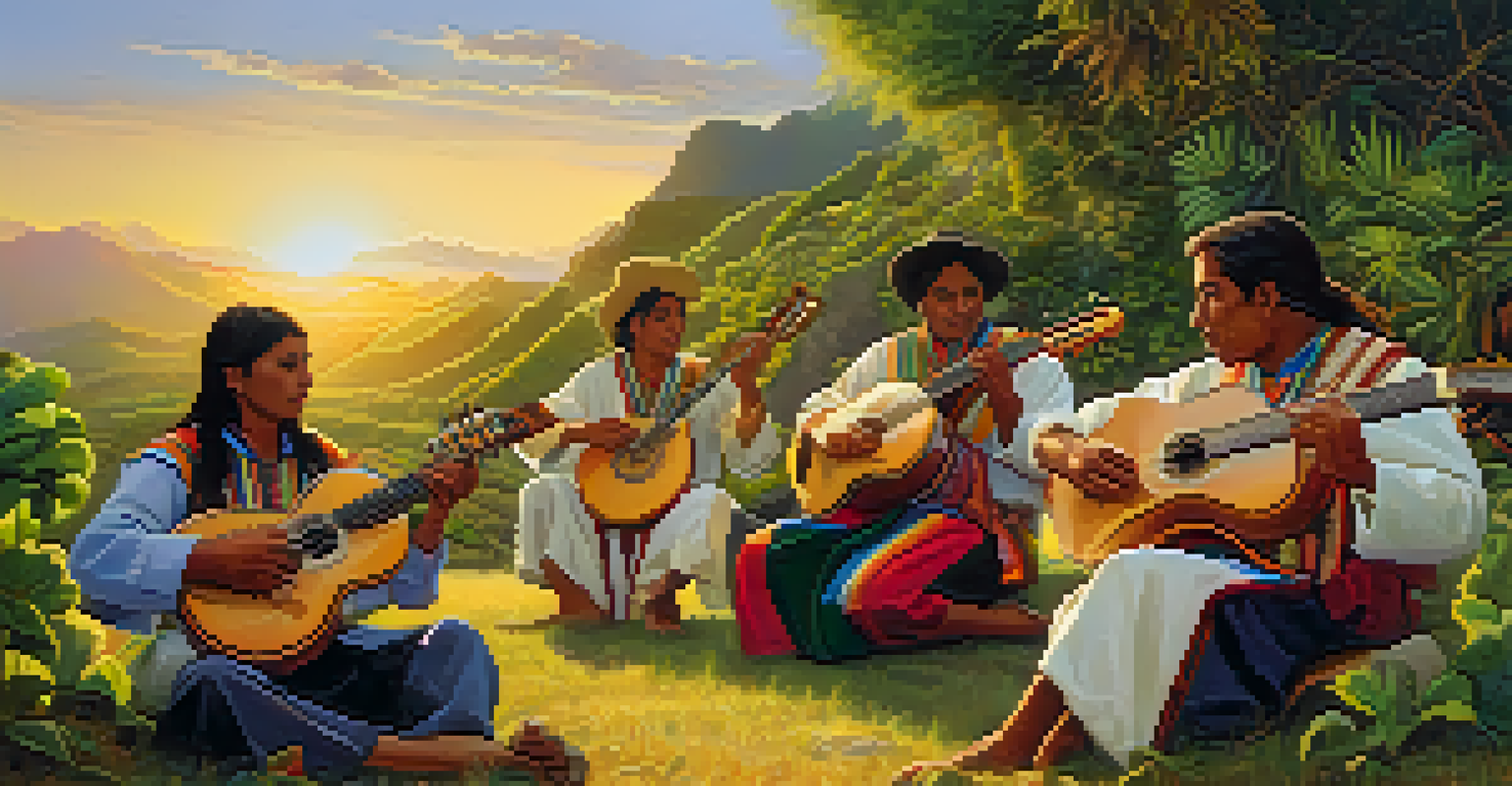Music and Dance: The Heartbeat of Andean Cultural Expression

The Rich Tapestry of Andean Music and Dance
Andean music and dance form a vibrant tapestry that reflects the region's diverse history and cultural influences. From the haunting melodies of the pan flute to the rhythmic beats of drums, these art forms capture the essence of Andean life. They serve not just as entertainment but as a means of storytelling, passing down traditions and values through generations.
Music is the shorthand of emotion.
In the Andes, music is often intertwined with celebrations, rituals, and everyday life. Dances like the 'Sikuri' or 'Diablada' bring communities together, creating a sense of belonging and shared identity. These performances are not just spectacles; they embody the spirit and resilience of the Andean people.
Moreover, the fusion of indigenous and Spanish musical traditions has given rise to unique styles and instruments, enriching the cultural landscape. This blend highlights the adaptability and creativity of Andean communities, ensuring that their music and dance remain relevant in today's world.
Instruments That Echo the Andes
The sounds of the Andes are defined by a variety of traditional instruments, each with its own unique character. The charango, a small string instrument made from an armadillo shell, creates bright, cheerful melodies that are instantly recognizable. Meanwhile, the siku, a type of pan flute, produces haunting harmonies that resonate deeply with listeners.

These instruments not only create music but also symbolize the connection between the Andean people and their environment. For example, many instruments are crafted from locally sourced materials, reflecting a deep respect for nature. This relationship is further emphasized in the way musicians perform, often drawing inspiration from the landscapes around them.
Andean Music: A Cultural Legacy
Andean music and dance serve as vital expressions of cultural identity, storytelling, and community bonding.
The craftsmanship involved in making these instruments is itself an art form, often passed down through families. This tradition ensures that the skills and knowledge remain alive, allowing future generations to continue the legacy of Andean music.
Dance as a Storytelling Medium
Dance in Andean culture goes beyond mere movement; it is a powerful form of storytelling. Each dance tells a story, often depicting historical events, agricultural practices, or mythological tales. As dancers perform, they embody the characters and emotions of these narratives, making the stories come alive for their audience.
Dance is the hidden language of the soul.
For instance, the 'Caporales' dance, characterized by energetic footwork and colorful costumes, celebrates the struggle and triumph of Afro-Bolivian communities. Through this dance, performers convey pride, resilience, and a joyful spirit that resonates with both the performers and the audience.
Moreover, dance serves as a way to preserve cultural heritage. As communities gather for festivals and celebrations, these dance performances create a shared experience that strengthens social bonds and reinforces cultural identity.
Festivals: The Heart of Andean Cultural Celebration
Festivals are integral to Andean culture, bringing music and dance to the forefront of community life. Events like Inti Raymi, the Festival of the Sun, showcase traditional performances that honor the Incan heritage. During these festivals, the atmosphere is charged with energy, as locals and visitors alike join in the celebrations.
These festivities not only highlight the artistic expression of music and dance but also serve important social and spiritual functions. They provide a space for community members to reconnect with their roots, celebrate their identity, and pay homage to their ancestors.
Instruments Reflect Nature's Essence
Traditional instruments like the charango and siku embody the deep connection between Andean people and their environment.
Additionally, festivals often attract tourism, creating opportunities for economic growth while also fostering a deeper appreciation of Andean culture among outsiders. This blend of tradition and modernity ensures that the heart of Andean culture continues to beat strong.
The Role of Music in Andean Spiritual Practices
In Andean culture, music plays a vital role in spiritual practices, serving as a bridge between the physical and spiritual worlds. Rituals often incorporate specific songs and instruments believed to invoke the presence of ancestors or deities. This connection fosters a sense of reverence and respect for nature and the cosmos.
Ceremonies such as 'Pachamama' (Mother Earth) celebrations are rich with music and dance, creating an atmosphere of gratitude and harmony. Participants often perform traditional songs that express their relationship with the earth, highlighting the importance of sustainability and stewardship.
The spiritual aspect of music in the Andes emphasizes the belief that every sound carries energy and meaning. Through music, Andean people articulate their hopes, fears, and aspirations, making it a powerful tool for both personal and communal expression.
Contemporary Influences on Andean Music and Dance
As the world evolves, so too does Andean music and dance, embracing contemporary influences while staying true to their roots. Modern musicians often blend traditional sounds with genres like rock, hip-hop, and electronic music, creating innovative fusions that appeal to younger audiences. This evolution showcases the adaptability of Andean culture.
For example, artists like Los Kjarkas have successfully integrated traditional instruments with contemporary rhythms, gaining international recognition. Their work not only preserves Andean music but also introduces it to a global audience, fostering cross-cultural dialogues.
Modern Influences Shape Traditions
Contemporary artists are blending traditional Andean music with modern genres, ensuring its relevance while preserving authenticity.
While some may fear that modernization could dilute traditional practices, many artists strive to maintain authenticity. They often draw inspiration from their heritage, ensuring that their music and dance reflect both the past and the present.
Preserving Andean Music and Dance for Future Generations
Preserving Andean music and dance is crucial for maintaining cultural identity in an ever-changing world. Initiatives such as workshops, community classes, and festivals aim to educate younger generations about their rich heritage. By engaging youth in these traditions, communities ensure that their cultural expressions continue to thrive.
Moreover, local organizations and artists are increasingly utilizing technology to document and share Andean music and dance. Through social media, video platforms, and digital archives, they reach wider audiences, fostering appreciation and understanding of their culture beyond geographical boundaries.

The commitment to preservation speaks to the resilience of Andean communities. By honoring their past while embracing modernity, they create a dynamic cultural landscape that is both rooted in tradition and open to innovation.